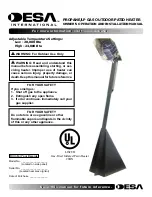
61
10
Operating information
(continued)
Installation & Service Manual
Low water cutoff protection
The electronic control module uses sensing of both heat
exchanger supply and return temperatures. If the flow rate
is too low or either temperature too high, the control module
modulates and shuts the burner down. This ensures water
heater shutdown in the event of low water or low flow
conditions in the heat exchanger.
To turn the heater ON/OFF
To turn the heater ON, press the UP button and hold it for five
(5) seconds. To turn the heater OFF, press the UP button and
hold again for five (5) seconds.
Service mode
⚠
WARNING
Entering Service Mode will immediately
cause the water heater to fire. Failure to
ensure that the unit is fully assembled and
installed and in safe working condition;
including having properly installed
venting, all air purged from the heat
exchanger, and with proper water supply
and flow, can result in serious injury,
death, significant property damage, or
destruction of the heater.
The Shield water heater includes a Service Mode feature that
can be used to force the unit to run at a particular firing rate.
This feature can be used by qualified service technicians for
adjusting combustion or troubleshooting the unit.
Service Mode can be accessed by holding
►
and
▼
buttons
simultaneously for 5 seconds.
Error logging
The control will hold the last 10 lockouts in memory. The date
and time of the occurrence will be recorded as well. Only the
10 most current occurrences will be held in memory.
Building Management System (BMS)
BMS
The Shield Water Heater can be controlled by a Building
Management System (BMS) ONLY if equipped with an
optional Modbus or BACnet control.
The water heater control can be configured by the installer
to use a 0-10 VDC signal to control either tank setpoint or
firing rate. When the BMS parameter is set to INACTIVE,
the 0 - 10 VDC input will be ignored. When set to
ACTIVE, the set point or modulation will be controlled
by the voltage on the 0 - 10 VDC input (in the case of
0 - 10 VDC BMS control), or the 0 - 10 VDC input value
received through ModBus or BACnet. The default value is
INACTIVE.
BMS type
When programmed for BMS control through ModBus/
BACnet, the 0 - 10 VDC signal can be interpreted as either
a modulation command or a set point. When the BMS
Type parameter is set to POWER, the 0 - 10 VDC signal
will control the modulation. When set to SETPOINT, the
0 - 10 VDC signal will control the hot water set point. The
default setting is SETPOINT.
Rate at minimum volts
When programmed for BMS control through ModBus/
BACnet and the BMS Type is programmed as POWER,
the modulation percentage represented by the Volts at
Minimum parameter is set by the Rate at Minimum Volts
parameter. The minimum value is 0% and the maximum
is the Rate at Maximum Volts setting. The default value is
model dependent.
Rate at maximum volts
When programmed for BMS control through ModBus/
BACnet and the BMS Type is programmed as POWER,
the modulation percentage represented by the Volts at
Maximum parameter is set by the Rate at Maximum Volts
parameter. The minimum value is the Rate at Minimum
Volts setting and the maximum is 100%. The default value
is 100%.
Setpoint at minimum volts
When programmed for BMS control through ModBus/
BACnet and the BMS Type is programmed as SETPOINT,
the set point represented by the Volts at Minimum
parameter is set by the Set Point at Minimum Volts
parameter. The minimum value is 60°F (0°C) and the
maximum is the Set Point at Maximum Volts setting. The
default value is 70°F (21°C).
Содержание Shield SWA150
Страница 53: ...53 Figure 9 2 Operating Instructions Models 125 285 9 Start up continued Installation Service Manual ...
Страница 54: ...54 Figure 9 3 Operating Instructions Models 400 500 9 Start up Installation Service Manual ...
Страница 82: ...82 Notes ...
Страница 83: ...83 Notes ...
Страница 84: ...Revision Notes Revision A PCP 3000038210 CN 500026403 initial release MM 100329111_DIR 2000585724 Rev A 04 20 ...
















































